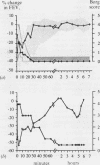Abstract
Perception of breathlessness was studied in eight patients with mild, stable asthma after a histamine and exercise challenge performed before and 24 and 48 hours respectively after an antigen challenge. FEV1 and perception of breathlessness, evaluated by Borg's 10 point category scale, were measured after each administration of doubling antigen or histamine concentrations to achieve a greater than 20% fall in FEV1, and after six minutes of steady state exercise at 80% of maximal oxygen consumption (VO2max). The geometric mean provocative concentration of histamine causing a 20% fall in FEV1 (PC20) fell from 1.67 mg/ml before antigen challenge to 0.52 mg/ml 24 hours after the challenge. The median maximal % fall in FEV1 with exercise was 24.9% (range 10.5-40.5%) before and 30.6% (range 13.8-52.3%) 48 hours after antigen challenge. The median maximum % fall in FEV1 after antigen inhalation was 20.1% (range 13.3-35.2%) within the first hour; only two subjects had a late fall in FEV1 (23% and 58%). The median (range) of Borg scores obtained when FEV1 was reduced by 20% did not differ significantly for the three types of acute challenges: 1.25 (0.5-2.5) and 1.0 (0.5-3.0) after histamine tests, 1.0 (0.5-4.1) and 1.55 (0.5-2.0) after exercise, and 1.5 (0-3.0) after antigen challenge. In the two subjects who had a late response to antigen the Borg score was reduced for the same % fall in FEV1 as with the early response. It is concluded that the perception of breathlessness does not differ appreciably during the early response to histamine, antigen exposure, or exercise, but that it is reduced during the late asthmatic response. It was not influenced by previous antigen exposure, despite an increase in airway responsiveness.
Full text
PDF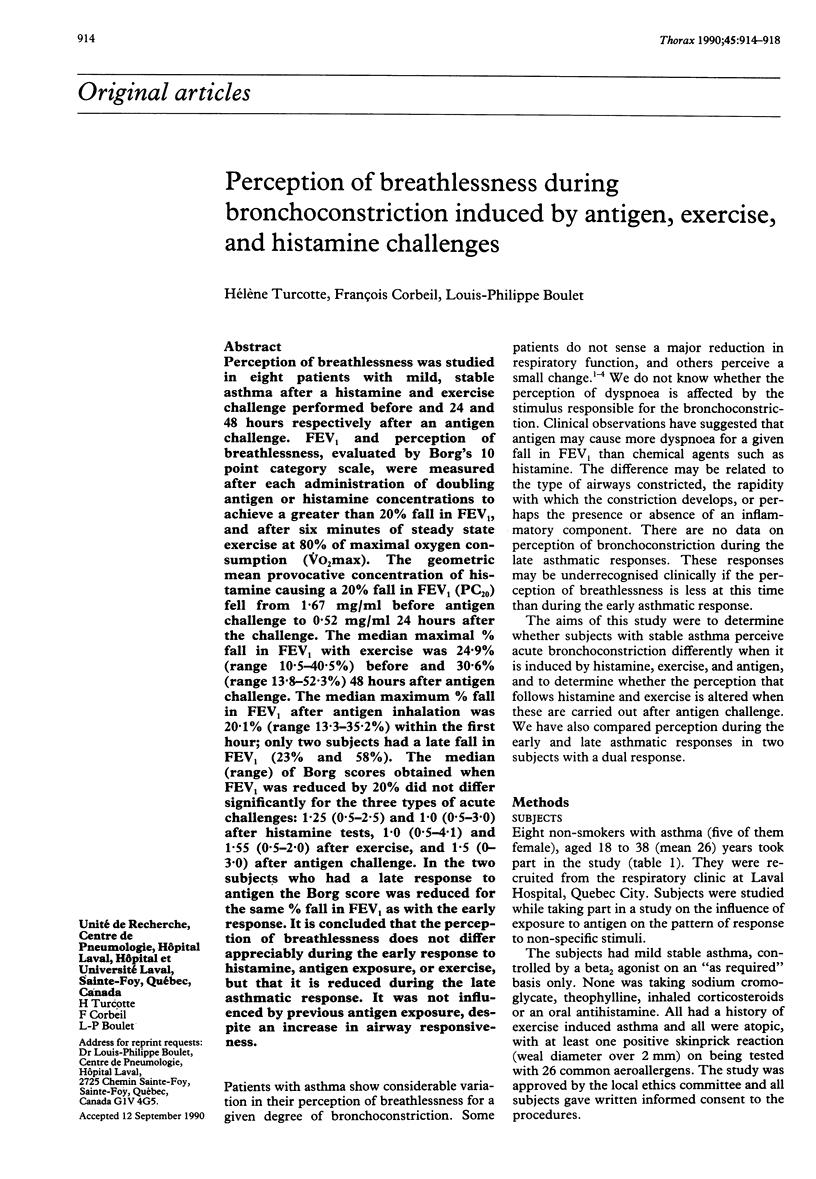
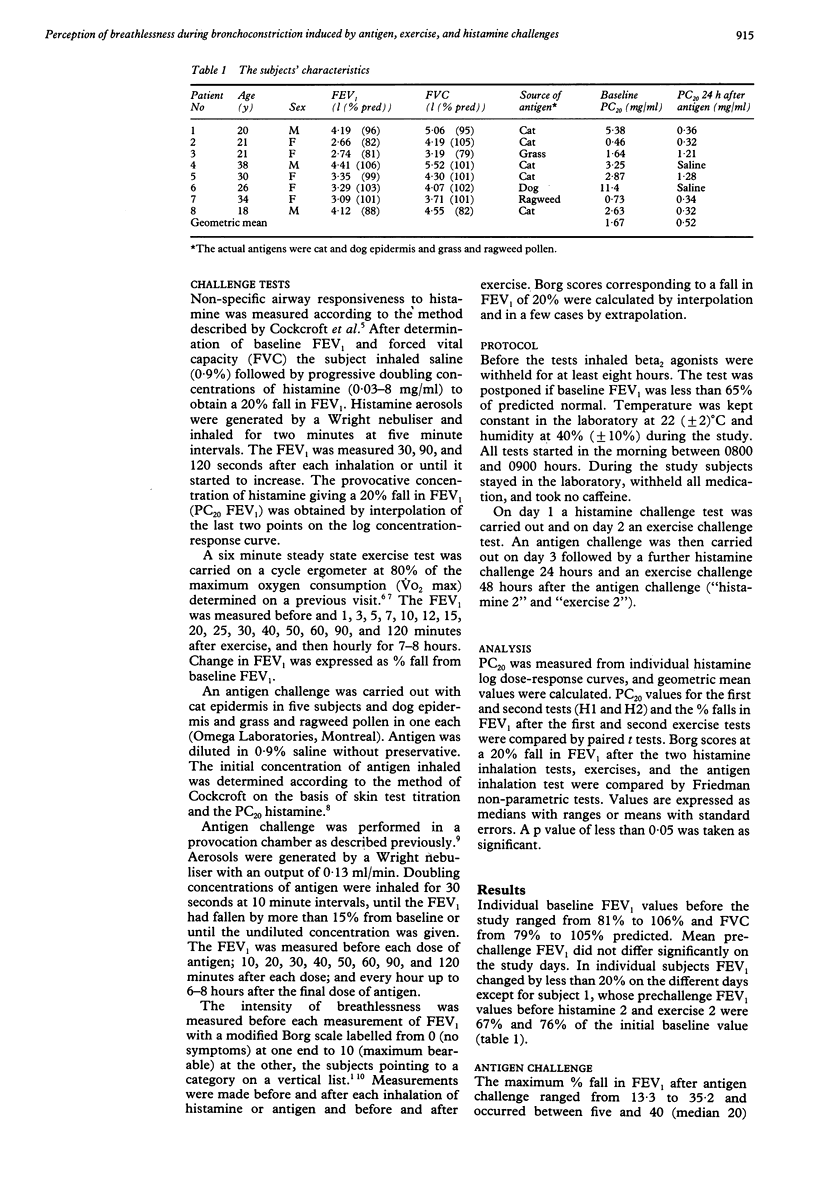
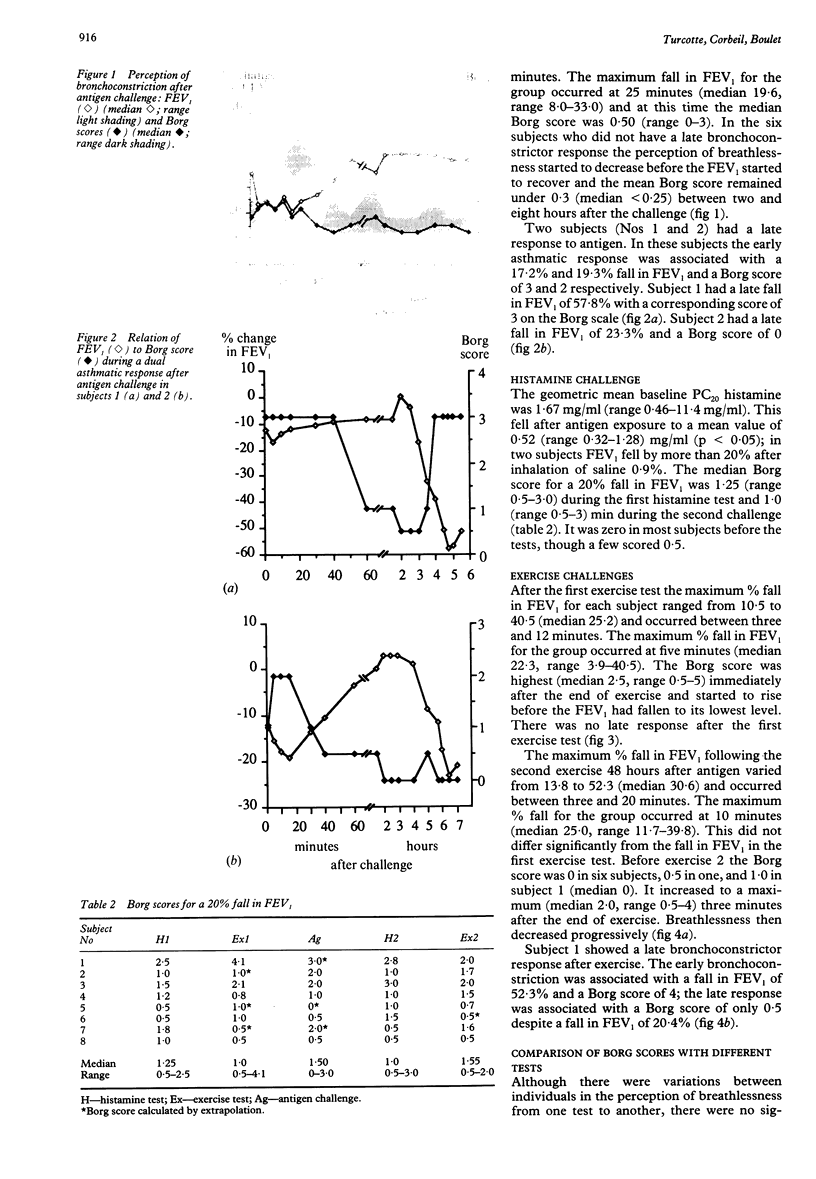
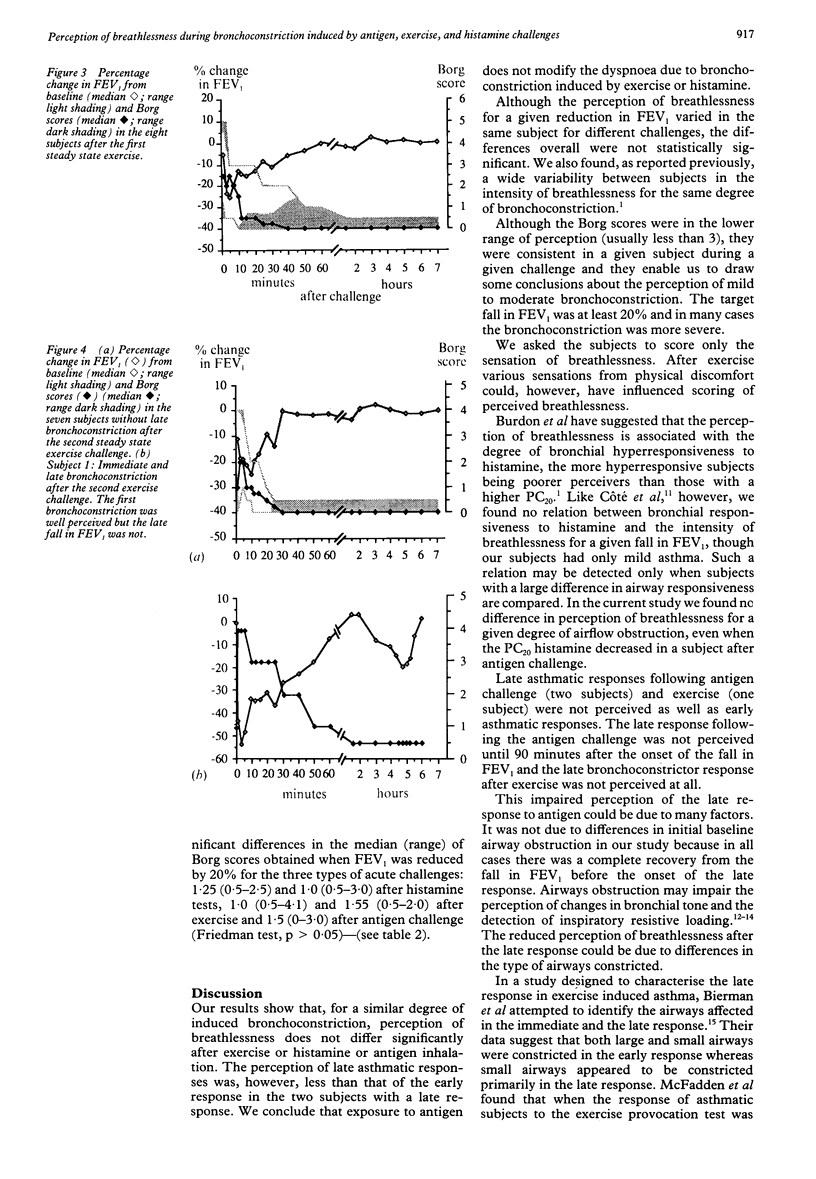

Images in this article
Selected References
These references are in PubMed. This may not be the complete list of references from this article.
- Bierman C. W., Spiro S. G., Petheram I. Characterization of the late response in exercise-induced asthma. J Allergy Clin Immunol. 1984 Nov;74(5):701–706. doi: 10.1016/0091-6749(84)90233-1. [DOI] [PubMed] [Google Scholar]
- Borg G. A. Psychophysical bases of perceived exertion. Med Sci Sports Exerc. 1982;14(5):377–381. [PubMed] [Google Scholar]
- Burdon J. G., Juniper E. F., Killian K. J., Hargreave F. E., Campbell E. J. The perception of breathlessness in asthma. Am Rev Respir Dis. 1982 Nov;126(5):825–828. doi: 10.1164/arrd.1982.126.5.825. [DOI] [PubMed] [Google Scholar]
- Burki N. K., Mitchell K., Chaudhary B. A., Zechman F. W. The ability of asthmatics to detect added resistive loads. Am Rev Respir Dis. 1978 Jan;117(1):71–75. doi: 10.1164/arrd.1978.117.1.71. [DOI] [PubMed] [Google Scholar]
- Cartier A., Thomson N. C., Frith P. A., Roberts R., Hargreave F. E. Allergen-induced increase in bronchial responsiveness to histamine: relationship to the late asthmatic response and change in airway caliber. J Allergy Clin Immunol. 1982 Sep;70(3):170–177. doi: 10.1016/0091-6749(82)90038-0. [DOI] [PubMed] [Google Scholar]
- Cockcroft D. W., Killian D. N., Mellon J. J., Hargreave F. E. Bronchial reactivity to inhaled histamine: a method and clinical survey. Clin Allergy. 1977 May;7(3):235–243. doi: 10.1111/j.1365-2222.1977.tb01448.x. [DOI] [PubMed] [Google Scholar]
- Cockcroft D. W., Murdock K. Y., Kirby J., Hargreave F. Prediction of airway responsiveness to allergen from skin sensitivity to allergen and airway responsiveness to histamine. Am Rev Respir Dis. 1987 Jan;135(1):264–267. doi: 10.1164/arrd.1987.135.1.264. [DOI] [PubMed] [Google Scholar]
- Cropp G. J. The exercise bronchoprovocation test: standardization of procedures and evaluation of response. J Allergy Clin Immunol. 1979 Dec;64(6 Pt 2):627–633. doi: 10.1016/0091-6749(79)90026-5. [DOI] [PubMed] [Google Scholar]
- Kerrebijn K. F., Fioole A. C., van Bentveld R. D. Lung function in asthmatic children after year or more without symptoms or treatment. Br Med J. 1978 Apr 8;1(6117):886–888. doi: 10.1136/bmj.1.6117.886. [DOI] [PMC free article] [PubMed] [Google Scholar]
- McFadden E. R., Jr, Kiser R., DeGroot W. J. Acute bronchial asthma. Relations between clinical and physiologic manifestations. N Engl J Med. 1973 Feb 1;288(5):221–225. doi: 10.1056/NEJM197302012880501. [DOI] [PubMed] [Google Scholar]
- McFadden E. R., Jr, Soter N. A., Ingram R. H., Jr Magnitude and site of airway response to exercise in asthmatics in relation to arterial histamine levels. J Allergy Clin Immunol. 1980 Dec;66(6):472–477. doi: 10.1016/0091-6749(80)90008-1. [DOI] [PubMed] [Google Scholar]
- Orehek J., Beaupré A., Badier M., Nicoli M. M., Delpierre S. Perception of airway tone by asthmatic patients. Bull Eur Physiopathol Respir. 1982 Jul-Aug;18(4):601–607. [PubMed] [Google Scholar]
- Palmer K. N., Kelman G. R. Pulmonary function in asthmatic patients in remission. Br Med J. 1975 Mar 1;1(5956):485–486. doi: 10.1136/bmj.1.5956.485. [DOI] [PMC free article] [PubMed] [Google Scholar]
- Peiffer C., Marsac J., Lockhart A. Chronobiological study of the relationship between dyspnoea and airway obstruction in symptomatic asthmatic subjects. Clin Sci (Lond) 1989 Sep;77(3):237–244. doi: 10.1042/cs0770237. [DOI] [PubMed] [Google Scholar]
- Rubinfeld A. R., Pain M. C. Perception of asthma. Lancet. 1976 Apr 24;1(7965):882–884. doi: 10.1016/s0140-6736(76)92097-3. [DOI] [PubMed] [Google Scholar]
- Silverman M., Barry J., Hellerstein H., Janos J., Kelsen S. Variability of the perceived sense of effort in breathing during exercise in patients with chronic obstructive pulmonary disease. Am Rev Respir Dis. 1988 Jan;137(1):206–209. doi: 10.1164/ajrccm/137.1.206. [DOI] [PubMed] [Google Scholar]





